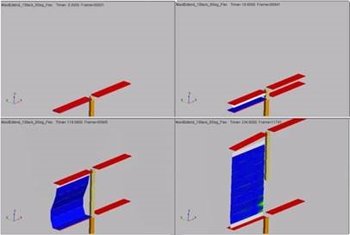Airbus Defence and Space Netherlands B.V. (ADSN) is a supplier of high-tech space equipment like launcher structures, instruments and solar arrays. The company is based in Leiden.
ADSN is currently developing a new type of deployable solar array called the Flexible Compact solar Array (FCA). In comparison to “conventional” solar arrays used in space the Flexible Compact Array does not consist of stiff carbon-fiber panels to carry the Photo-Voltaic Assembly (PVA), but instead consists of a flexible blanket on which the PVA is attached. This blanket is zig-zag folded and compressed in stowed condition and can be deployed once the satellite is in orbit by several mechanisms.
 The deployment of the FCA is significantly more complex than the modelling of the deployment of a conventional solar array. This is mostly caused by the many flexible bodies present in the design. Current efforts on modeling this deployment behavior could not model more than 8 flexible blanket segments within a reasonable amount of computation time, see figure below. In order to model the deployment of a full sized FCA with up to 40 flexible segments more efficient modelling techniques need to be used. Different methods and techniques are available to represent a component in a multi-body dynamics environment (ADAMS). It is up to the student to find out how to represent these components with a trade-off on computational efficiency, computational stability and accuracy of the physical behavior.
The deployment of the FCA is significantly more complex than the modelling of the deployment of a conventional solar array. This is mostly caused by the many flexible bodies present in the design. Current efforts on modeling this deployment behavior could not model more than 8 flexible blanket segments within a reasonable amount of computation time, see figure below. In order to model the deployment of a full sized FCA with up to 40 flexible segments more efficient modelling techniques need to be used. Different methods and techniques are available to represent a component in a multi-body dynamics environment (ADAMS). It is up to the student to find out how to represent these components with a trade-off on computational efficiency, computational stability and accuracy of the physical behavior.
- Company supervisor: ir. Sjoerd de Bekker
- UT supervisor: dr. ir. Marcel Ellenbroek
For more information on this thesis please contact:

